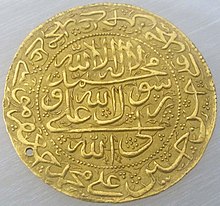Tahmasp II
This article includes a list of references, related reading, or external links, but its sources remain unclear because it lacks inline citations. (December 2023) |
| Tahmasp II | |
|---|---|
 Court scene with Tahmasp II in the centre, and Nader to his left. From a illustrated Indian copy of the Jahangosha-ye Naderi, dated 1757/58 | |
| Shah of Iran | |
| Reign | 10 November 1722 – 1732 |
| Predecessor | Soltan Hoseyn (Qazvin) Ashraf Hotak (Isfahan) |
| Successor | Abbas III |
| Born | 1704 |
| Died | 11 February 1740 (aged 35–36) Sabzevar |
| Spouse | Shahpari Begum |
| Issue | Abbas III Hossein Esmat-nesa begum |
| House | Safavi |
| Father | Soltan Hoseyn |
Tahmasp II (Persian: شاه تهماسب دوم, romanized: Ṭahmāsb; 1704? – 11 February 1740) was the penultimate Safavid shah of Iran, ruling from 1722 to 1732.
Name
[edit]Tahmasp (Persian: طهماسب, romanized: Ṭahmāsb) is a New Persian name, ultimately derived from Old Iranian *ta(x)ma-aspa, meaning "having valiant horses."[1] The name is one of the few instances of a name from the Shahnameh being used by an Islamic-era dynasty based in Iran.[2] In the Shahnameh, Tahmasp is the father of Zaav, the penultimate shah of the Pishdadian dynasty.[3]
Biography
[edit]Tahmasp was the son of Soltan Hoseyn, the Shah of Iran at the time. When Soltan Hoseyn was forced to abdicate by the Afghans in 1722, Prince Tahmasp wished to claim the throne.[citation needed] From the besieged Safavid capital, Isfahan, he fled to Qazvin, where he on 10 November 1722 declared himself shah and assumed the regnal name of Tahmasp II.[4] He gained the support of the Sunni Muslims of the Caucasus (even that of the previously rebellious Lezgins), as well as several Qizilbash tribes (including the Afshars, under the control of Iran's future ruler, Nader Shah).
Russo-Persian War
[edit]In June 1722, Peter the Great, the then tsar of the neighbouring Russian Empire, declared war on Safavid Iran in an attempt to expand Russian influence in the Caspian and Caucasus regions and to prevent its rival, Ottoman Empire, from territorial gains in the region at the expense of declining Safavid Iran.
The Russian victory ratified for Safavid Irans' cession of their territories in the Northern, Southern Caucasus and contemporary mainland Northern Iran, comprising the cities of Derbent (southern Dagestan) and Baku and their nearby surrounding lands, as well as the provinces of Gilan, Shirvan, Mazandaran, and Astrabad to Russia per the Treaty of Saint Petersburg (1723).[5]

Tahmasp also eventually gained the recognition of both the Ottoman Empire and Russia, each worried about the other gaining too much influence in Iran.[vague]
By 1729, Tahmasp had control of most of the country. Quickly after his foolhardy Ottoman campaign of 1731, he was deposed by the future Nader Shah in 1732 in favor of his son, Abbas III; both were murdered at Sabzevar in 1740 by Nader Shah's eldest son Reza-qoli Mirza.
See also
[edit]References
[edit]- ^ Hinz 1975, p. 232.
- ^ Ansari 2012, p. 25 (see note 74).
- ^ Justi 1895, p. 319.
- ^ Roemer 1986, p. 326.
- ^ William Bayne Fisher, P. Avery, G. R. G. Hambly, C. Melville. The Cambridge History of Iran, Volume 7 Cambridge University Press, 10 okt. 1991 ISBN 0521200954 p 319
Sources
[edit]- Akopyan, Alexander V. (2021). "Coinage and the monetary system". In Matthee, Rudi (ed.). The Safavid World. Routledge. pp. 285–309.
- Ansari, Ali Mir (2012). The Politics of Nationalism in Modern Iran. Cambridge University Press. ISBN 978-0521687171.
- Newman, Andrew J. (2008). Safavid Iran: Rebirth of a Persian Empire. I.B.Tauris. pp. 1–281. ISBN 9780857716613.
- Hinz, Walther (1975). "Altiranisches Sprachgut der Nebenüberlieferungen". Göttinger Orientforschungen, Reihe III, Iranica (in German). 3. Wiesbaden: Otto Harrassowitz.
- Justi, Ferdinand (1895). Iranisches Namenbuch (in German). Marburg: N. G. Elwert’sche Verlagsbuchhandlung.
- Babaie, Sussan (2004). Slaves of the Shah: New Elites of Safavid Iran. I.B.Tauris. pp. 1–218. ISBN 9781860647215.
- Roemer, H.R. (1986). "The Safavid period". The Cambridge History of Iran, Volume 5: The Timurid and Safavid periods. Cambridge: Cambridge University Press. pp. 189–351. ISBN 9780521200943.
- Lawrence Lockhart, Nadir Shah (London, 1938)
- The Armenian Rebellion of the 1720s and the Threat of Genocidal Reprisal, Armen Ayvazyan, Yerevan 1997
